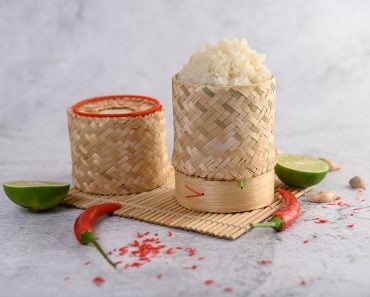Table of Contents (click to expand)
The reason for the sliminess of okra is the mucilaginous fiber present in okra pods, which dissolves in water and becomes slimy. For plants, mucilage is a tool to protect the plant by preventing the loss of water, especially when the plant is young.
If you’ve ever cut and cooked okra, then you know about the gooey and slimy ‘juice’ of the okra that sticks to the knife and your hand. This slippery and sticky mass only gets slipperier and stickier when the okra touches water.
Some of us absolutely dislike this slime and try to find ways to get rid of it. Others enjoy its texture and use it in recipes like soups and sauces to get just the right consistency.
Apart from food, okra slime actually has many uses in the food processing, pharmaceutical, and sewage treatment industries. .

Recommended Video for you:
What Is Okra?
Okra (Abelmoschus esculentus) belongs to the family Malvaceae, along with cotton, cocoa, and hibiscus. It is also known by the names gumbo (in the southern US) and lady’s finger (in the UK).
Okra is believed to have originated in Africa. The plant grows primarily in the warm tropical and subtropical areas of the world. Okra is mostly popular because of its immature edible green pods (fruits). However, its seeds, mucilage, and stem fiber also have various industrial uses.
It ranks high in nutritional value and is a rich source of dietary fiber, vitamin A, vitamin C, and minerals (calcium, potassium, copper, iron, phosphorus, magnesium, zinc, and manganese). Okra seed meal contains 16-17% protein.
Okra is used in traditional medicine and is known for its antidiabetic, antioxidant, and cholesterol-lowering activities. It is also used to treat gastrointestinal issues, such as worms and dysentery.

What Makes It Slimy And Does The Sliminess Have Any Use?
Okra pods contain a viscous substance called mucilage or gum. The mucilage is actually the soluble fiber and is made of polysacchrarides, such as galactose, rhamnose, and galacturonic acid.
Some people dislike the slime and try to find ways to get rid of it, or at least reduce it while cooking. Others, however, take advantage of its viscous properties. African and Southern US cuisines take advantage of the sliminess and use okra to make soups and stews.
Due to its perceived medicinal properties, okra mucilage also has applications in the nutraceutical industry.
Since it is sourced from a plant and is non-toxic, it is used in the food processing industry as an emulsifier. In the pharmaceutical industry, it’s used as a coating for drugs, as well as a thickener, stabilizer, gelling agent, granulating agent, suspending agent, binder, and sustained release agent. It is also used to make biodegradable films for food.
Okra mucilage has been tested as a low-cost and eco-conscious way to handle wastewater treatment, as it can help to separate out solids from liquids to make the water less turbid.

Why Do Plants Produce Mucilage?
Okra is not the only plant that produces mucilage. Other common plants that produce mucilage include aloe vera, chia, some varieties of cactus, and taro.
Some plants, including okra, produce mucilage from the seed coat (an addition to explain what a seed coat is). This mucilage helps prevent premature seed germination. The mucilage also protects the germinating seedling from drought stress and serves as an energy source.
When mucilage is produced from leaves and buds, it helps the leaves retain water during times of water scarcity. It also helps with food storage. When the roots produce the mucilage, it helps to lubricate the root tips, which improves water content, water uptake and the absorption of ions from the soil.
Can You Avoid The Sliminess?
The mucilage is a part of the okra pod, so there’s no way to completely avoid it. However, chef-recommended ‘tips and tricks’ to reduce the sliminess include keeping the pods intact while frying them, adding acidic ingredients, such as vinegar, tomato, or lemon, slicing the pod while keeping the stem intact, leaving cut okra to dry overnight, and using high heat, such as deep frying, before adding other ingredients.
The viscosity of the okra mucilage is highest when the pH is neutral, which is why marinating or cooking with an acidic ingredient helps to reduce the sliminess. However, if your recipe needs thick slime, then you might want to add baking soda.

Conclusion
Love it or hate it, there’s no way to avoid it. Okra will come with mucilage. However, okra has high nutritional value, so instead of avoiding okra because of the slime, you can try out some ‘tricks’ to reduce the sliminess. The mucilage has numerous industrial uses in food processing, pharmaceutical and sewage treatment as well, so it’s probably a good thing that we still have to deal with it in the kitchen!
References (click to expand)
- Araújo, A., Galvão, A., Filho, C. S., Mendes, F., Oliveira, M., Barbosa, F., … Bastos, M. (2018, October). Okra mucilage and corn starch bio-based film to be applied in food. Polymer Testing. Elsevier BV.
- Dantas, T. L., Alonso Buriti, F. C., & Florentino, E. R. (2021, August 16). Okra (Abelmoschus esculentus L.) as a Potential Functional Food Source of Mucilage and Bioactive Compounds with Technological Applications and Health Benefits. Plants. MDPI AG.
- Foundation Food Search Options - FoodData Central - USDA.
- Tosif, M. M., Najda, A., Bains, A., Kaushik, R., Dhull, S. B., Chawla, P., & Walasek-Janusz, M. (2021, March 28). A Comprehensive Review on Plant-Derived Mucilage: Characterization, Functional Properties, Applications, and Its Utilization for Nanocarrier Fabrication. Polymers. MDPI AG.
- How to cook okra that tastes great and isn't slimy.













